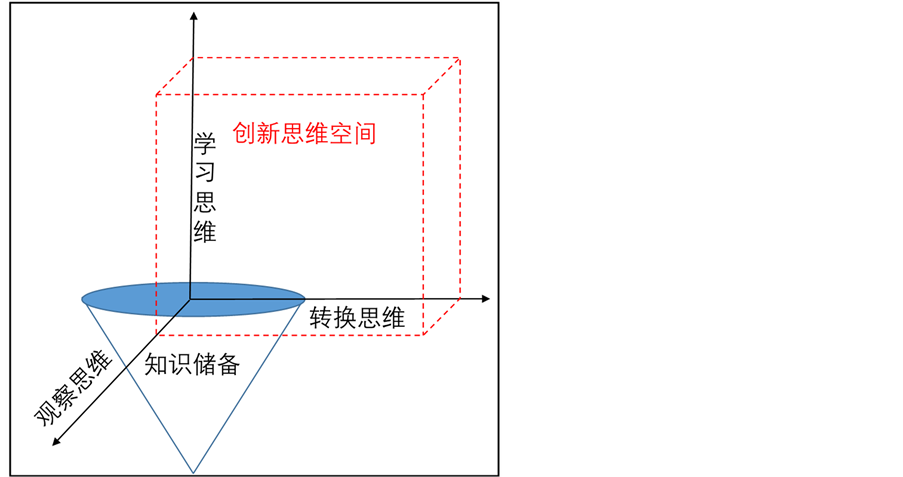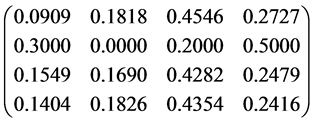1. 引言
知识经济时代,创新成为了推动全世界社会发展的主要动力,而创新精神、创新意识和创新能力则决定了创新能否实现 [1] 。创新思维是创新的灵魂,创新教育是影响创新思维水平的关键手段之一 [2] 。世界范围内,各国家都纷纷意识到,要通过创新思维的培养来培养创新人才。
思维是人脑对客观事物的一般特性和规律性的一种概括的、间接的反映过程 [3] 。创新思维要求敢于怀疑旧观念、旧思想,要善于建构新知识的能力。创新思维是衡量新时代人才的重要指标,也是新时期高等院校人才培养的着力点。
高等院校作为培养创新型人才的重要阵地,培养学生创新思维,渗透到教学体系的各方面。美国各高校在大学生创新思维培养方面一直走在世界的前列,且美国高校毕业生也被世界公认为创新思维水平较高。作为航空业人才的摇篮,航空院校肩负着航空工业创新发展、航空商业创新服务的重要任务。中美两国,航空院校学生创新思维的差异直接影响着中美两国航空业的竞争力。
本文基于中国民航大学和美国佛罗里达理工学院的问卷调查,以中美航空院校学生为对象,研究其创新思维的差异与培养措施,力求为我校、乃至我国航空人才的创新思维培养提供决策支持。
2. 创新思维的内涵及测评
2.1. 创新思维的内涵
关于创新思维,在我国存在一系列类似、相近、易混淆的词汇。大多是根据“创新”的更新、创造新的东西、改变这三个层次的内涵衍生而出的,往往对应的英文包括强调新方法的Innovative,强调产生新东西的Creative和强调改变的Improve。
本质上创新思维是一种具有独创性、跨越性、发散性以及综合性等特征的思维方式。创新思维重点在于让思维跳出原来的轨道,不按照既定的思维方式和思维角度,开拓出更多的想象空间,从而取得更多新的成果,提升思考的维度。
2.2. 创新思维的培养
一般情况下,创新思维由三种思维组合而成,如图1所示,即观察思维、学习思维和转换思维。其中,观察思维强调目的性、条理性、预测性、敏锐性、独创性、系统性和持久性;学习思维强调不断夯实的知识基础,不断提升的知识层次,不断跨越的知识领域;转换思维则更强调有实践能力保障的整合、嫁接和革新。
创新思维的培养和创新思维水平的提升,主要是针对以上三种思维的锻炼和提高,探讨的是如何将创新与固有的思维模式相结合;如何形成多视角、多方位的思维活动;如何摆脱旧观念,具备国际化视野的新思维。这些也正是现有教学体制改革迫切需要解决的问题。
2.3. 创新思维的测试
国内外研究学者主要采用心理测验法、实验法、个案研究法、生物统计法和计算机模拟法等方法研究创新思维 [4] 。其中,心理测验法是运用最广泛、最方便的方法,常通过一套标准化的题目,在一定的时间内,按照一定的步骤和程序对被试施测。该方法计分简单、实施容易、可操作性强、结果易于统计和解释、数据可量化。
心理测验法中,常见的、公认的创新思维测量工具包括:托兰斯创造性思维测验(Torrance Tests of Creative Thinking, TTCT) [5] ,威廉斯创造力倾向测量表(Welsh Figure Preference Test, WFPT) [6] ,创造性思维测验(Test of Creative Imagination, TCI) [7] ,远程联想测验(Remote Associates Test, RAT) [8] ,同感评估技术(Consensus Assessment Technique, CAT) [9] 等。研究表明,TCI作为一项新的工具,具有易于挖据创新思维、受年龄及种族文化影响弱、题目简单、数量少和容易把握等优势。因此本文以创造性思维测验(TCI及其中文修订版本TCI-C) [10] 为主要研究工具,为了避免TCI中的测评的主观性,还结合了WFPT测试。
TCI的总测验时间不超过30分钟,其由2个项目组成,适合任何年龄群体,评分采用流畅性、变通性、独特性三个标准计算得分,参照(1, 1.25, 1.5, 1.75, 2)得分进行评估。WFPT包含50个题目,涉及冒

Figure 1. 3D schematic of creative thinking
图1. 创新思维的三维拆解示意图
险性、好奇性、想象力和挑战性4个因素,总测验时间也为30分钟。
3. 创新思维调查实施与结果
中国民航大学(Civil Aviation University of China, CAUC)坐落于天津市,始建于1951年,是中国民用航空局直属高校,设置28个本科专业。佛罗里达理工学院(Florida Institute of Technology, FIT)位于美国佛罗里达州墨尔本市,始建于1958年,由美国国家航空航天局专家团队创办,在航空科学、工程科学、理科学、心理学和商业科学等领域具有很高的世界知名度。其中,航空学院致力于为学生提供通往飞行与非飞行航空职业的教育方案,学院设置了多个学士学位、硕士学位、博士学位课程,也为世界知名航空公司提供飞行员培训课程,例如:航空管理、航空气象学、航空计算机科学、航空学机场开发与管理、航空人为因素、航空安全应用等。通过创新思维调查研究的核心问题是:在创新思维水平上,中国民航大学和美国佛罗里达理工学院是否存在差异?如果存在差异,差异有多大?在创新思维的哪些方面存在差异?
3.1. 调查过程描述
通过在2015年4月到2016年4月期间,对美国佛罗里达理工学院学生和中国民航大学学生进行TCI和WFPT测试,测试调查分阶段展开。
第一阶段,2015年4月~6月,使用调查问卷在中国民航大学进行了内测。共进行2次内测,每次测试学生人数5~8人不等。通过内测,了解了中国学生对于问题理解、问卷长度等方面看法,并进行了针对性的修正和完善。并在问卷调查过程要严格控制作答时间。
第二阶段,2015年7月~9月,使用英文问卷对美国佛罗里达理工学院学生进行了2次随机模拟测试,测试学生人数6~9人不等。通过模拟测试,针对美国学生对于调查的看法,对问卷进行了针对性的修改。
第三阶段,2015年10月~12月,对美国佛罗里达理工学院学生进行正式调查工作。
第四阶段,2016年3月~4月,对中国民航大学学生进行正式调查工作。
为了提高被试的参与积极性,针对美国学生被试发放了印有中国汉字的卡夹,针对中国学生被试发放了美国风景明信片。
3.2. 调查对象情况
中国民航大学和美国佛罗里达理工学院参与TCI和WFPT测试的学生分别是68人和42人。为了表述方便,后文中国民航大学学生和美国佛罗里达理工学院学生对应简称中美学生。
中国民航大学现有各类在校学生24,000余人,本次调查学生选择的是2015~2016(2)学期,选修物流案例分析课程的学生。调查共获得60个有效样本,其中10级占1.7%,12级占3.3%,13级占30.0%,14级占36.7%,15级占28.3%;男生占75%,女生占25%;被试涉及18个专业,以交通运输专业学生最多,占21.7% (如表1所示),未涉及到的专业包括乘务、飞行及部分专科专业;被试学生的班级分布中,英语专业的5名学生全部来自140641E班,有3名电子信息工程*专业学生来自151044B班,无同班同学被试的比例为43.3%;所有被试的平均年龄为20.4,以上特征符合中国民航大学本科在校生的特征,具备较高的代表性。
美国佛罗里达理工学院被试全部来自于选修了William B. Rankin教授运输物流(Transportation Logistics)课程的学生,调查共获得40个有效样本,被试的平均年龄为22.5,男女生比例为9:1,被试40名学生来自14专业(如表2所示),其中留学生占20%,其中1名学生来自于加拿大,2名学生来自印度,1名学生来自中国台湾,4名学生来自中南美洲国家。

Table 1. Statistical distribution of students majors from CAUC
表1. 中国民航大学学生被试的专业分布情况统计

Table 2. Statistical distribution of students majors from FIT
表2. 美国佛罗里达理工学院学生被试的专业分布情况统计
3.3. 调查数据处理
通过问卷调查的形式,将收集到的数据统一录入Excel,并进行多轮复核以保障数据质量,删除无效数据、缺失数据和胡乱作答等情况,再使用Excel进行描述性统计分析,并进行创新思维在性别和专业两方面的中美差异比较。其中,对两组测试,共回收100份问卷,采用Pearson积差相关系数计算信度,结果显示信度分别为0.687、0.726,均达到非常显著的水平(p < 0.01),这说明本次调查测试具备很好的信度。
3.4. 调查结果分析
3.4.1 中美学生TCI和WFPT测评结果的整体对照
通过从流畅性、变通性和独特性三个方面对TCI中两个项目进行评估,调查结果显示:中美学生的创新思维整体存在差异,如图2所示。中国学生整体创新思维水平不如美国学生,但是在具体项目的判定过程中,中国学生表现出了更高的变通性,两者在独特性水平上相当,在流畅性上美国学生优于中国学生。
对中美学生的WFPT调查结果显示,中美学生在冒险性、好奇性、挑战性和想象力四个方面都具备差异,如图3所示。可以发现,中美学生在想象力上存在的差异最大,其次是挑战性、冒险性和好奇性,其中两者在好奇性上的差异最小。

Figure 2. TCI results comparison between CAUC and FIT
图2. 中美学生TCI结果对照

Figure 3. WFPT results comparison between CAUC and FIT
图3. 中美学生WFPT结果对照
3.4.2. 不同性别和专业的中美学生创新思维水平比较
通过对100个被试的创新思维水平的调查发现,被试中男、女被试的平均分情况如表3所示。中美被试在TCI和WFPT测试中,女生的创新思维水平差异大于男生的创新思维水平差异。
通过对100名中美学生被试的专业进行匹配分析,虽然部分专业的名称不同,但是根据所修课程、毕业去向、授课教师的学科来源和科研方向等内容,可以找到6组相类似的专业。根据调查资料,被试中这6组专业的中美学生总分对别如表4所示。

Table 3. Gender differences of creative thinking between CAUC and FIT
表3. 中美学生创新思维水平的性别差异

Table 4. Major differences of creative thinking between CAUC and FIT
表4. 中美学生创新思维的专业差异
显然,中美被试在TCI和WFPT测试中,机械电子工程专业的中国被试创新思维水平明显好于美国被试,而其他专业的中国被试与美国被试在创新思维水平之间均有一定的差距。其中,计算机科学与技术专业中美被试的创新思维水平差异最大,而后依次为安全工程、土木工程、飞行器动力工程/飞行器制造工程和交通工程/交通运输等专业。
4. 创新思维影响因素判断
4.1. 指标体系
根据对创新思维的内涵和培养的分析,通过分解创新思维的培养目标,建立了创新思维影响因素判断指标体系,并采用层次分析法计算出各一级和二级指标的权重值,如表5所示。指标的评语集采用80~100为影响很大;70~80为影响较大;60~70为影响一般;0~60为影响差。
4.2. 判定过程
根据对中美100个被试进行的调查,由专家根据调查结果对问卷进行评分,并将各项指标得分进行汇总。以创新观察能力为例,首先,用各指标评语分数除以某项评语总分计算出创新观察能力二级指标各子域的隶属度向量:

其次,可以计算出创新观察能力二级指标各子域的模糊综合评价向量:


Table 5. Indexes and weights of creative thinking factors analyzing
表5. 创新思维影响因素判断指标体系及指标权重
同理,可以计算出其他各二级指标各子域的模糊综合评价向量,分别是:



最后,可以计算综合评定得分:创新知识储备的影响得分为74.02、创新观察能力的影响得分为73.49、创新转换能力的影响得分为71.49、创新学习能力的影响得分为75.80。
4.3. 结果分析
根据评定结果可以发现创新学习能力对创新思维的影响最大,其次为创新知识储备,而后是创新观察能力和创新转换能力。一方面说明创新思维并不是与生俱来的,是可以通过后天知识储备和学习提升的,另一方面说明观察世界比改造世界更能有效提升创新思维水平。具体而言,知识储备水平和国际化视野是影响创新思维发生的关键,问题导向性自主学习、坚持不懈的探索和实践动手能力则是影响创新思维转化的核心。
5. 创新思维培养探讨
尽管本研究仅以中国民航大学和美国佛罗里达理工学院这两所航空院校作为案例进行比较分析,且选择被试样本有限,但所获结论在一定程度上反映出我国航空院校在学生创新思维培养中存在的普遍问题。根据调查和分析结果,结合对被试学生进行的访谈,发现有以下三点值得提倡:
5.1. 增加立体化、综合性案例
创新思维是在实践应用中培养和提高的。实践教学就是让学生亲身去实践自己在课堂上所学到的知识,在操作中发现事物的规律,实现发现问题,分析问题,并最终解决问题 [11] 。综合案例教学则往往是在大型、真实实践活动有限的情况下,通过教师采用的综合性较强的案例,将学生带入到具体情境中,让学生将所学知识应用到具体决策过程中的一种行为。对于航空业的理论、技术和方法的学习往往属于很难进行实践的范畴,因此可以通过强化综合案例教学提高学生创新思维水平。
以《企业物流管理》课程为例,该课程为中国民航大学物流管理专业大三的课程,课程理论知识以工业制造类企业为核心展开,由于学生缺乏实践,对知识点很难形成立体把握,可以通过引入《世界航空制造业巨头波音公司的物流发展》综合性案例,通过对波音787飞机全球供应链真实解读,让学生将所学的生产物流及时制造JIT、供应商库存管理VMI和供应链协同管理等内容与案例分析一同进行深入理解。
5.2. 融入开放式、设计性实验
传统的实验教学以验证性教学为主,教师采用先讲解、再演示,最后由学生进行验证的方法 [12] 。在这一过程中,学生多处于被动的学习状态,只能按照老师给定的思维方向去操作、去验证已学的知识,缺乏自主思考与自由发挥的余地,束缚了学生创新思维的培养。
开放式设计性实验则强调由教师提出问题,在实验室开放时间内,由学生根据技术专长、兴趣爱好、知识储备情况组成团队,根据自身学习要求,自主安排实验时间和实验步骤等。这种实验行为不受课堂框架的限制,而且极大的丰富了不同层次学生学习的需求,有利于创新思维的培养。
以《空港物流规划与管理》课程为例,该课程为中国民航大学物流工程专业研究生一年级的课程,课程以空港物流规划理论为核心,强调对学生空港物流规划实践能力的培养。以往课程中,总是老师给学生讲解规划理论、常见的规划方法、规划实例和规划步骤等。通过融入开放式、设计性实验,可以通过给学生提出问题,如“天津滨海国际机场空港物流将如何实现100万吨吞吐量目标?”,从而让学生利用实验室,自主进行知识查阅、信息检索、数据搜集等,并根据所学的规划理论为天津滨海国际机场的空港物流进行规划。具体而言:
第一,可以为学生提供基础历史资料,由学生对天津机场空港物流发展历程进行总结,分析影响天津机场空港物流发展的关键因素。第二、可以为学生提供天津机场的航空货运现状及预测数据,让学生应用空港物流功能规模的确定方法,对天津机场空港物流发展需要的设施规模进行确定,并与现状设施规模进行对比分析,使学生一方面掌握空港物流功能规模的确定方法,另一方面对天津机场空港物流发展进行科学的分析。并可以应用课程自主开发软件进行规模测算与分析。
第三、可以为学生提供天津机场空港物流的现状图,一方面通过现状讲解,使学生了解天津机场空港物流的总体布局现状,另一方面通过网络文献搜集与实地调研相结合的方式,对天津机场空港物流总体布局现状有深刻感受。
第四、建议学生采用摆样法、SLP等方法对天津机场空港物流总体布局进行设计,最终由学生给出建议性方案,并说明方案的选择依据,对比分析过程等。
5.3. 引导科学化使用思维导图
知识与创造思维之间关系非常复杂,学者们一直致力于弄清楚两者之间的本质联系,从而通过有效的方法促进创新思维的培养 [13] 。为了促进创新,一方面知识的数量和质量都是非常重要的,另一方面就是让个体在多领域知识或单领域内尽力探索,从而促进创新思维的发挥。知识的多元性和系统性是创新思维培养的关键。
研究表明:概念图的结构在一定程度上反映了个体的知识网络和激活程度,其层级越多,个体在单领域内的激活越深。这也说明思维导图是提高知识多元性和系统性上是一种有效方法。思维导图总是从一个中心点开始,每个与其相关的词或者图像都成为一个子中心或者联想,整个合起来以一种无穷无尽的分支链的形式从中心向四周放射,回归于一个共同的中心。思维导图善用左右脑的功能,借助颜色、图像、符码的使用,不但可以协助记忆,还可以增进创新思维 [14] 。
以《飞机构型与维修基础》和《航空器材计划与管理》课程为例,这两个课程同属于中国民航大学物流管理专业的航材课程群,属于前序和后续课程,其中《飞机构型与维修基础》课程在大三上学期完成,《航空器材计划与管理》课程在大三下学期进行。航材管理涉及企事业单位多,包括航空器设计和制造企业(波音、空客、西飞等)、航空器的OEM生产商、航空器的维修单位(AMECO、GAMECO、TAECO等)、航材经销商以及行业监管与组织单位(FAA、EASA、CAAC)等。航材管理涉及的规章和文件繁多,包括CCAR-21部、CCAR-145部、CCAR-25部、ATA-2000、ATA-300和AC121-58R2等。其中,每个单位对应涉及的规章和文件中的重点内容不同,而且《飞机构型与维修基础》重点围绕航空器的制造和维修展开,《航空器材计划与管理》则重点围绕航空营运人的航空器材需求计划展开,前后知识体系融合,知识必须高度衔接。这就可以采用思维导图进行知识梳理,以航空器为核心,首先按照航空器的生命周期将设计、制造、运营、维修和报废里面涉及的单位、规章和文件及核心内容进行整理;其次,重点围绕航空器运营过程中的航材的计划、采购、维修、供应商管理、索赔、报废和销售进行整理;最终明确各部分之间的关系,从而将课程群的知识形成网状结构,强化记忆、提高创新。
6. 结论
创新思维水平的测量与评价是一项复杂的系统工程,不能仅通过各种测试问题来判断,但有限的题目仍然可以反映一定的事实。总体而言,美国佛罗里达理工学院的学生创新思维水平明显较高。中美学生在想象力上存在的差异最大,依次是挑战性、冒险性和好奇性。其中,两者在好奇性上的差异最小。虽然中国被试的整体创新思维水平不如美国被试,但中国被试的变通性普遍较强,具备较大的创新潜力。
调查结果反映了中美大学生的普遍情况,针对这一测试对比结果,借助多层次模糊综合评价模型判断影响创新思维的关键因素,结果发现:创新学习能力对创新思维的影响最大,其次为创新知识储备,而后是创新观察能力和创新转换能力。具体而言,知识储备水平和国际化视野是影响创新思维发生的关键,问题导向性自主学习、坚持不懈的探索动力和实践动手能力则是影响创新思维转化的核心。
根据调查和分析结果,结合访谈,发现增加立体化、综合性案例,融入开放式、设计性实验,引导学生科学使用思维导图是三种培养学生创新思维的有效方式。然而,关于创新思维培养的探讨并未形成系统化的分析,且具体论述以物流管理专业课程为实例展开,并未涉及其他专业,覆盖面小,这些都是后期研究中需要改进的地方。
基金项目
本文受中国民航大学院级优质课《企业物流管理》资助。